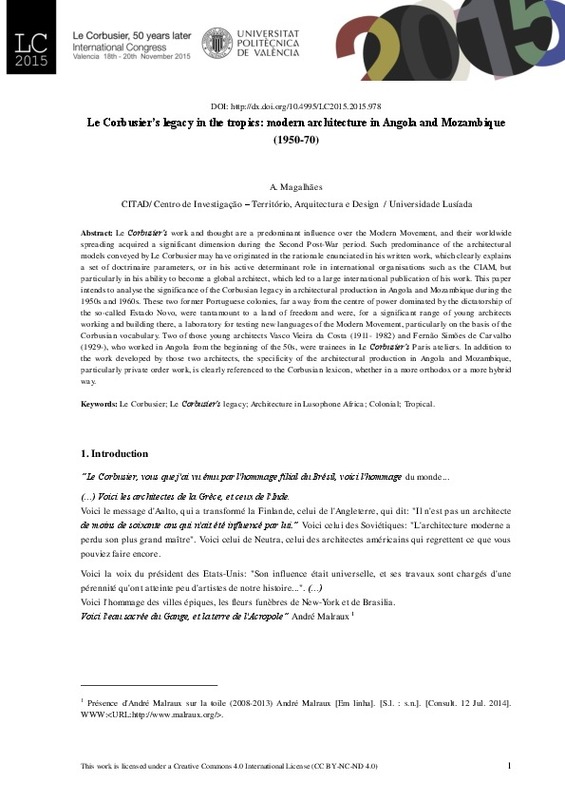JavaScript is disabled for your browser. Some features of this site may not work without it.
Buscar en RiuNet
Listar
Mi cuenta
Estadísticas
Ayuda RiuNet
Admin. UPV
Le Corbusier’s legacy in the tropics: modern architecture in Angola and Mozambique (1950-70)
Mostrar el registro sencillo del ítem
Ficheros en el ítem
| dc.contributor.author | Magalhães, Ana
|
es_ES |
| dc.date.accessioned | 2017-09-14T07:16:23Z | |
| dc.date.available | 2017-09-14T07:16:23Z | |
| dc.date.issued | 2016-03-03 | |
| dc.identifier.isbn | 9788490483732 | |
| dc.identifier.uri | http://hdl.handle.net/10251/87263 | |
| dc.description.abstract | [EN] Le Corbusier’s work and thought are a predominant influence over the Modern Movement, and their worldwide spreading acquired a significant dimension during the Second Post-War period. Such predominance of the architectural models conveyed by Le Corbusier may have originated in the rationale enunciated in his written work, which clearly explains a set of doctrinaire parameters, or in his active determinant role in international organisations such as the CIAM, but particularly in his ability to become a global architect, which led to a large international publication of his work. This paper intends to analyse the significance of the Corbusian legacy in architectural production in Angola and Mozambique during the 1950s and 1960s. These two former Portuguese colonies, far away from the centre of power dominated by the dictatorship of the so-called Estado Novo, were tantamount to a land of freedom and were, for a significant range of young architects working and building there, a laboratory for testing new languages of the Modern Movement, particularly on the basis of the Corbusian vocabulary. Two of those young architects Vasco Vieira da Costa (1911- 1982) and Fernão Simões de Carvalho (1929-), who worked in Angola from the beginning of the 50s, were trainees in Le Corbusier’s Paris ateliers. In addition to the work developed by those two architects, the specificity of the architectural production in Angola and Mozambique, particularly private order work, is clearly referenced to the Corbusian lexicon, whether in a more orthodox or a more hybrid way. | es_ES |
| dc.format.extent | 12 | es_ES |
| dc.language | Inglés | es_ES |
| dc.publisher | Editorial Universitat Politècnica de València | es_ES |
| dc.relation.ispartof | LE CORBUSIER. 50 AÑOS DESPUÉS | es_ES |
| dc.rights | Reconocimiento - No comercial - Sin obra derivada (by-nc-nd) | es_ES |
| dc.subject | architecture | es_ES |
| dc.subject | le corbusier | es_ES |
| dc.subject | modern movement | es_ES |
| dc.title | Le Corbusier’s legacy in the tropics: modern architecture in Angola and Mozambique (1950-70) | es_ES |
| dc.type | Capítulo de libro | es_ES |
| dc.type | Comunicación en congreso | es_ES |
| dc.identifier.doi | 10.4995/LC2015.2015.978 | |
| dc.rights.accessRights | Abierto | es_ES |
| dc.description.bibliographicCitation | Magalhães, A. (2016). Le Corbusier’s legacy in the tropics: modern architecture in Angola and Mozambique (1950-70). En LE CORBUSIER. 50 AÑOS DESPUÉS. Editorial Universitat Politècnica de València. 1253-1264. https://doi.org/10.4995/LC2015.2015.978 | es_ES |
| dc.description.accrualMethod | OCS | es_ES |
| dc.relation.conferencename | LC2015 - Le Corbusier, 50 years later | es_ES |
| dc.relation.conferencedate | November 18-20,2015 | es_ES |
| dc.relation.conferenceplace | Valencia, Spain | es_ES |
| dc.relation.publisherversion | http://ocs.editorial.upv.es/index.php/LC2015/LC2015/paper/view/978 | es_ES |
| dc.description.upvformatpinicio | 1253 | es_ES |
| dc.description.upvformatpfin | 1264 | es_ES |
| dc.type.version | info:eu-repo/semantics/publishedVersion | es_ES |
| dc.relation.pasarela | OCS\978 | es_ES |








